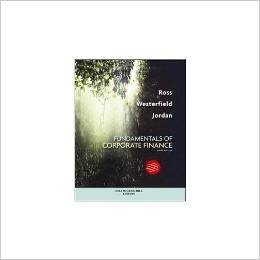
Fundamentals Of Corporate Finance, Tenth Standard Edition
10th Edition
ISBN: 9781121571938
Author: Westerfield, Jordan, 2013 Ross
Publisher: Mcgraw-Hill
expand_more
expand_more
format_list_bulleted
Concept explainers
Textbook Question
Chapter 17.1, Problem 17.1CCQ
How should the price of a stock change when it goes ex dividend?
Expert Solution & Answer
Want to see the full answer?
Check out a sample textbook solution
Students have asked these similar questions
Need help with the Correct answer of this Financial Accounting Question
: A project costs $100,000 and is expected to generate cash flows of $30,000 annually for 5 years. If the discount rate is 8%, should the project be accepted based on Net Present Value (NPV)?
You are considering a project in Poland, which has an initial cost of 250,000PLN. The project is expected to return a one-time payment of 400,000PLN 5 years from now. The risk-free rate of return is 3% in Canada and 4% in Poland. The inflation rate is 2% in Canada and 5% in Poland. Currently, you can buy 375PLN for $100. How much will the payment 5 years from now be worth in dollars?
Question 6 options:
$1,576,515
$1,489,025
$101,490
$1,462,350
$142,060
Chapter 17 Solutions
Fundamentals Of Corporate Finance, Tenth Standard Edition
Ch. 17.1 - Prob. 17.1ACQCh. 17.1 - What are the mechanics of the cash dividend...Ch. 17.1 - How should the price of a stock change when it...Ch. 17.2 - How can an investor create a homemade dividend?Ch. 17.2 - Prob. 17.2BCQCh. 17.3 - Prob. 17.3ACQCh. 17.3 - Why do flotation costs favor a low payout?Ch. 17.4 - Why might some individual investors favor a high...Ch. 17.4 - Prob. 17.4BCQCh. 17.5 - How does the market react to unexpected dividend...
Ch. 17.5 - Prob. 17.5BCQCh. 17.6 - Prob. 17.6ACQCh. 17.6 - Prob. 17.6BCQCh. 17.8 - Prob. 17.8ACQCh. 17.8 - How does the accounting treatment of a stock split...Ch. 17 - Dividends are paid to the parties listed as...Ch. 17 - Prob. 17.3CTFCh. 17 - Prob. 17.4CTFCh. 17 - Prob. 17.8CTFCh. 17 - Dividend Policy Irrelevance [LO2] How is it...Ch. 17 - Prob. 2CRCTCh. 17 - Prob. 3CRCTCh. 17 - Prob. 4CRCTCh. 17 - Prob. 5CRCTCh. 17 - Prob. 6CRCTCh. 17 - Prob. 7CRCTCh. 17 - Prob. 8CRCTCh. 17 - Prob. 9CRCTCh. 17 - Prob. 10CRCTCh. 17 - Prob. 1QPCh. 17 - Prob. 2QPCh. 17 - Prob. 3QPCh. 17 - Prob. 4QPCh. 17 - Prob. 5QPCh. 17 - Prob. 6QPCh. 17 - Prob. 7QPCh. 17 - Prob. 8QPCh. 17 - Prob. 9QPCh. 17 - Prob. 10QPCh. 17 - Prob. 11QPCh. 17 - Prob. 12QPCh. 17 - 13. Expected Return, Dividends, and Taxes [LO2]...Ch. 17 - Dividends and Taxes [LO2] As discussed in the...Ch. 17 - Prob. 15QPCh. 17 - Prob. 16QPCh. 17 - Prob. 1MCh. 17 - Prob. 2MCh. 17 - Prob. 3MCh. 17 - Prob. 4MCh. 17 - Prob. 5MCh. 17 - Prob. 6M
Knowledge Booster
Learn more about
Need a deep-dive on the concept behind this application? Look no further. Learn more about this topic, finance and related others by exploring similar questions and additional content below.Similar questions
- : A project costs $100,000 and is expected to generate cash flows of $30,000 annually for 5 years. If the discount rate is 8%, should the project be accepted based on Net Present Value (NPV)? i need hellarrow_forwardYou invest 60% of your money in Asset A (expected return = 8%, standard deviation = 12%) and 40% in Asset B (expected return = 5%, standard deviation = 8%). The correlation coefficient between the two assets is 0.3. What is the expected return and standard deviation of the portfolio? helparrow_forwardImporters and exporters are key players in the foreign exchange market. Question 10 options: True Falsearrow_forward
- Triangle arbitrage helps keep the currency market in equilibrium. Question 9 options: True Falsearrow_forwardThe use of dividends is a method by which a foreign subsidiary can remit cash to its parent company. Question 8 options: True False\arrow_forwardThe notion that exchange rates adjust to keep the purchasing power of a currency constant across countries is called: Question 7 options: Interest rate parity. The unbiased forward rates condition. Uncovered interest rate parity. Purchasing power parity. The international Fisher effect.arrow_forward
- The notion that exchange rates adjust to keep the purchasing power of a currency constant across countries is called: Question 7 options: Interest rate parity. The unbiased forward rates condition. Uncovered interest rate parity. Purchasing power parity. The international Fisher effect.arrow_forwardSuppose the direct exchange rate for the Canadian dollar and U.S. dollar is 1.11, this means that you can buy $1 U.S. for $1.11 Canadian. Question 5 options: True Falsearrow_forwardThe 60-day forward rate for Japanese Yen is x108.02 per $1. The spot rate is x103.09 per $1. In 60 days you expect to receive x1,500,000. If you agree to a forward contract, how many dollars will you receive in 60 days? Question 4 options: $154.635 million $15,312 million $13,886 million $14,550 millionarrow_forward
arrow_back_ios
SEE MORE QUESTIONS
arrow_forward_ios
Recommended textbooks for you
 Intermediate Financial Management (MindTap Course...FinanceISBN:9781337395083Author:Eugene F. Brigham, Phillip R. DavesPublisher:Cengage Learning
Intermediate Financial Management (MindTap Course...FinanceISBN:9781337395083Author:Eugene F. Brigham, Phillip R. DavesPublisher:Cengage Learning EBK CONTEMPORARY FINANCIAL MANAGEMENTFinanceISBN:9781337514835Author:MOYERPublisher:CENGAGE LEARNING - CONSIGNMENT
EBK CONTEMPORARY FINANCIAL MANAGEMENTFinanceISBN:9781337514835Author:MOYERPublisher:CENGAGE LEARNING - CONSIGNMENT

Intermediate Financial Management (MindTap Course...
Finance
ISBN:9781337395083
Author:Eugene F. Brigham, Phillip R. Daves
Publisher:Cengage Learning

EBK CONTEMPORARY FINANCIAL MANAGEMENT
Finance
ISBN:9781337514835
Author:MOYER
Publisher:CENGAGE LEARNING - CONSIGNMENT
Stockholders Equity: How to Calculate?; Author: Accounting University;https://www.youtube.com/watch?v=2jZk1T5GIlw;License: Standard Youtube License